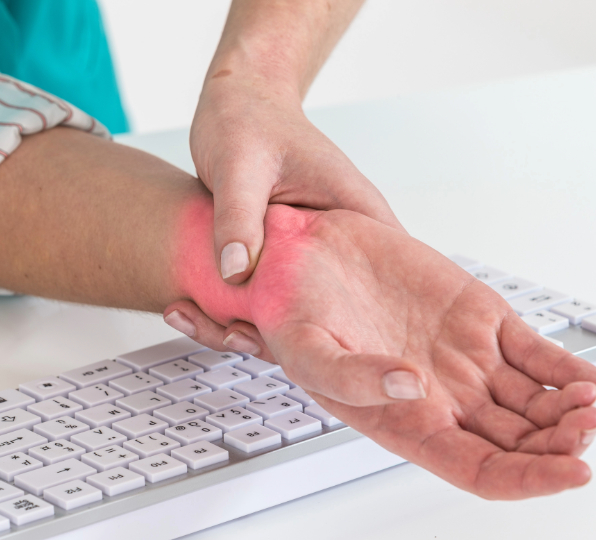Introduction:
The thick cord that connects muscles to bones is called a tendon, and tendinitis, or tendonitis, is a common condition marked by inflammation or irritation of the tendon. Tendinitis can affect any tendon in the body, but it most frequently affects the knees, elbows, shoulders, wrists, and heels. Managing and avoiding tendinitis requires an understanding of its causes, symptoms, and available treatments.
1. Causes of Tendinitis
Tendinitis, also known as tendonitis, is a condition characterized by inflammation or irritation of a tendon, the thick fibrous cord that attaches muscle to bone. Several factors contribute to the development of tendinitis, ranging from overuse and age-related changes to biomechanical issues and underlying medical conditions. Understanding these causes is crucial for preventing tendinitis and managing symptoms effectively.
One of the primary causes of tendinitis is overuse, particularly in activities that involve repetitive movements or high levels of stress on the tendons. Sports such as running, tennis, golf, and baseball, as well as occupations that require repetitive motions, such as typing or assembly line work, can strain the tendons over time, leading to inflammation and irritation. Continuous stress on the tendons without adequate rest or recovery can exacerbate symptoms and increase the risk of tendinitis.
Age-related changes in tendon structure and function also contribute to the development of tendinitis. As people age, tendons become less flexible and more susceptible to injury and inflammation. The gradual loss of collagen and elastin fibers in tendons reduces their elasticity and resilience, making them more prone to damage from repetitive stress or trauma. Additionally, age-related changes in blood flow and tissue regeneration processes can impair the body’s ability to repair damaged tendons, further increasing the risk of tendinitis.
Poor posture or biomechanics during physical activities can also predispose individuals to tendinitis. Improper alignment or technique can place excessive stress on specific tendons, leading to inflammation and irritation over time. For example, poor lifting mechanics or improper running form can strain the tendons in the shoulders, elbows, knees, or ankles, increasing the likelihood of tendinitis development.
Inadequate warm-up or cool-down routines before and after physical activity can also contribute to the development of tendinitis. Skipping warm-up exercises deprives the muscles and tendons of the necessary preparation and increases the risk of injury during exercise. Similarly, neglecting to cool down after physical activity can impede the body’s ability to recover and repair damaged tissues, prolonging inflammation and increasing the risk of tendinitis.
Furthermore, certain medical conditions can predispose individuals to tendinitis. Conditions such as rheumatoid arthritis, diabetes, gout, and thyroid disorders can affect tendon health and increase susceptibility to inflammation and injury. Additionally, medications such as corticosteroids or fluoroquinolone antibiotics may weaken tendons and increase the risk of tendinitis development.
In summary, tendinitis can result from a combination of factors, including overuse, age-related changes, poor posture or biomechanics, inadequate warm-up or cool-down routines, and underlying medical conditions. By understanding these causes and taking proactive measures to address risk factors, individuals can reduce the likelihood of tendinitis and maintain optimal tendon health. Implementing proper training techniques, incorporating adequate rest and recovery periods, and seeking treatment for underlying medical conditions can help prevent tendinitis and promote overall musculoskeletal health.
2.Symptoms of Tendinitis
Tendinitis, characterized by inflammation or irritation of a tendon, manifests through a range of symptoms that can vary in severity depending on the extent of tissue damage and the underlying cause. Understanding these symptoms is crucial for early detection and timely intervention to prevent further injury and promote recovery.
One of the hallmark symptoms of tendinitis is pain, which typically presents as a dull ache or sharp sensation in the affected tendon. This pain is often exacerbated by movement or activity that involves the affected tendon and may worsen over time if left untreated. The intensity of pain can vary depending on the severity of inflammation and the extent of tendon damage.
Swelling is another common symptom of tendinitis, resulting from the body’s inflammatory response to tissue injury. Inflammation of the tendon can cause localized swelling and tenderness around the affected area, which may be accompanied by redness or warmth. Swelling can contribute to discomfort and may limit mobility in the affected joint or muscle.
Stiffness is a frequent complaint among individuals with tendinitis, as inflammation and tissue damage can restrict joint mobility and range of motion. Stiffness may be most pronounced upon waking in the morning or after prolonged periods of rest, gradually improving with movement and activity. However, persistent stiffness can impair functional abilities and impact daily activities.
Weakness may also occur in cases of severe tendinitis or chronic tendon damage. The affected tendon may be unable to bear weight or perform its usual function, resulting in diminished strength and power in the affected area. Weakness may be particularly noticeable during activities that require forceful or repetitive use of the affected tendon, such as lifting objects or performing athletic movements.
It’s essential to recognize these symptoms of tendinitis and seek medical evaluation if you experience persistent pain, swelling, stiffness, or weakness in a tendon or joint. Early diagnosis and appropriate treatment are key to managing tendinitis effectively and preventing complications such as tendon rupture or chronic pain.
3.Common Types of Tendinitis
Tendinitis can affect various tendons throughout the body, with certain types being more common due to specific activities or anatomical factors. Understanding the different types of tendinitis and their associated symptoms is crucial for accurate diagnosis and targeted treatment approaches.
One of the most well-known types of tendinitis is tennis elbow, also known as lateral epicondylitis. This condition involves inflammation of the tendons on the outside of the elbow, near the bony bump called the lateral epicondyle. Tennis elbow often develops due to repetitive gripping and wrist movements, such as those involved in racquet sports, manual labor, or activities that require repetitive arm motion. Symptoms of tennis elbow include pain and tenderness on the outside of the elbow, which may radiate down the forearm, along with weakness and difficulty performing gripping tasks.
Achilles tendinitis is another common type of tendinitis that affects the Achilles tendon, the large tendon that connects the calf muscles to the heel bone. This condition is frequently seen in runners, athletes, and individuals who engage in activities that involve repetitive jumping or pushing off the foot. Achilles tendinitis typically presents with pain and stiffness in the back of the heel or lower calf, particularly during physical activity or upon waking in the morning.
Rotator cuff tendinitis involves inflammation of the tendons in the shoulder, specifically those that make up the rotator cuff, a group of muscles and tendons that stabilize the shoulder joint. This type of tendinitis often results from overuse, trauma, or age-related degeneration of the rotator cuff tendons. Symptoms of rotator cuff tendinitis include shoulder pain, especially with overhead movements or reaching behind the back, as well as weakness and limited range of motion in the affected shoulder.
De Quervain’s tenosynovitis is characterized by inflammation of the tendons on the thumb side of the wrist, which pass through a narrow tunnel known as the tendon sheath. This condition can develop due to repetitive thumb and wrist movements, such as texting, typing, or lifting objects with a twisting motion. Symptoms of De Quervain’s tenosynovitis include pain, swelling, and difficulty moving the thumb and wrist, particularly during activities that involve gripping or pinching.
Overall, these common types of tendinitis share similar underlying mechanisms, including repetitive stress or overuse of specific tendons, leading to inflammation and irritation. Proper diagnosis and management of tendinitis involve identifying the affected tendon, understanding the contributing factors, and implementing targeted treatment strategies to alleviate symptoms and promote healing.
4.Treatment Options for Tendinitis
- Treatment options for tendinitis aim to alleviate pain, reduce inflammation, and promote healing of the affected tendon. Depending on the severity and duration of symptoms, various conservative and medical interventions may be recommended to manage tendinitis effectively.
- Rest is often the first line of treatment for tendinitis, allowing the affected tendon time to heal and recover from overuse or injury. Avoiding activities that exacerbate symptoms, such as repetitive movements or heavy lifting, can prevent further damage and promote healing.
- Ice therapy, or cryotherapy, is commonly used to reduce inflammation and relieve pain associated with tendinitis. Applying ice packs or cold compresses to the affected area for 15-20 minutes several times a day can help constrict blood vessels, decrease swelling, and numb the area to alleviate discomfort.
- Over-the-counter pain relief medications, such as nonsteroidal anti-inflammatory drugs (NSAIDs) like ibuprofen or naproxen, are often recommended to help manage pain and inflammation associated with tendinitis. These medications can be taken orally or applied topically in the form of creams or gels to provide relief directly to the affected area.
- Physical therapy plays a crucial role in the management of tendinitis by focusing on strengthening and stretching exercises to improve flexibility, mobility, and muscle balance around the affected tendon. A physical therapist can tailor an exercise program to address specific deficits and biomechanical issues contributing to tendinitis, helping to prevent recurrence and promote long-term recovery.
- In cases of persistent or severe tendinitis, corticosteroid injections may be considered to deliver anti-inflammatory medication directly into the affected tendon or surrounding tissue. While corticosteroid injections can provide temporary relief from pain and inflammation, they are typically used judiciously due to the risk of tendon weakening or rupture with repeated injections.
- In rare instances where conservative treatments fail to provide relief, surgical intervention may be necessary to repair or remove damaged tissue and restore normal function to the affected tendon. Surgical procedures for tendinitis may include tendon debridement, tendon repair, or tendon transfer, depending on the location and severity of the injury.
- Overall, the choice of treatment for tendinitis depends on individual factors such as the underlying cause, severity of symptoms, and response to previous interventions. A comprehensive approach that combines rest, ice therapy, medication, physical therapy, and, if necessary, surgical intervention can effectively manage tendinitis and facilitate recovery, allowing individuals to return to their normal activities with minimal pain and dysfunction.


Conclusion:
Calisthenics offers a holistic approach to fitness that emphasizes bodyweight movements, functional strength, and overall well-being. Whether you’re a beginner looking to improve your strength and flexibility or an experienced athlete seeking new challenges, calisthenics provides a versatile and effective training method that can be tailored to meet your individual goals. Embrace the beauty of movement, strength, and vitality with calisthenics as you embark on your journey to a healthier, stronger, and more resilient self.












